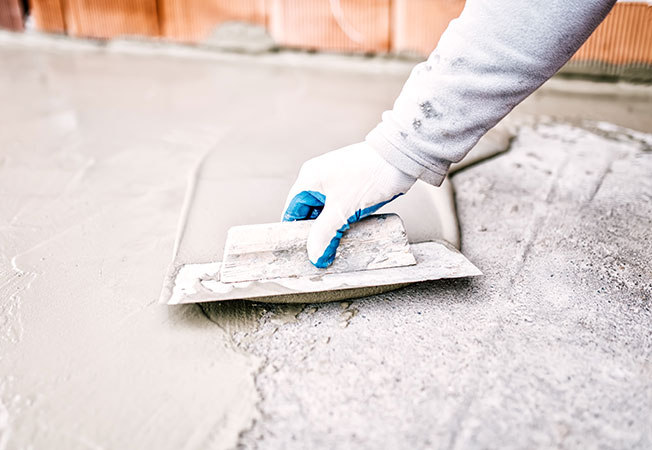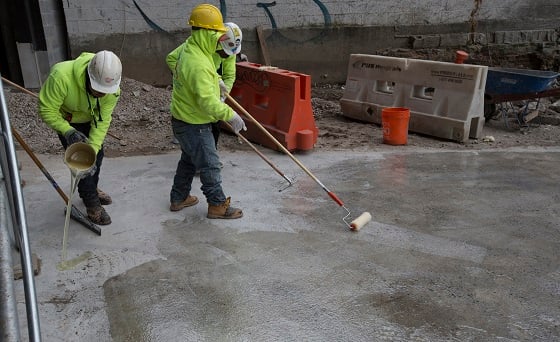Signs You Need a Drainage & waterproofing company Omaha Before It’s Too Late
Exactly How Waterproofing Works: A Detailed Check Out Methods and Technologies
Waterproofing is important for protecting frameworks from moisture-related damage. It involves numerous methods and technologies that produce barriers versus water invasion. Conventional approaches, such as compacted clay, coexist with contemporary innovations like liquid-applied membranes. Comprehending the nuances of these strategies is important for reliable application. Nevertheless, the performance of any kind of waterproofing service pivots not only on the strategies used yet also on continuous upkeep and evaluation. What are the key factors that affect lasting performance?
Comprehending the Essentials of Waterproofing
Waterproofing is an important procedure that secures structures from water invasion, which can cause substantial damage in time. This technique entails the application of numerous products and techniques developed to produce an obstacle versus dampness. The key goal is to avoid water from permeating surface areas, which can create deterioration, mold development, and structural instability.Various factors influence the choice of waterproofing technique, including the kind of framework, its place, and environmental conditions. Comprehending the physics of water motion and the residential or commercial properties of different materials is important in choosing an efficient waterproofing solution.Effective waterproofing not just safeguards structures yet additionally boosts their long life and stability. Commonly, it is incorporated right into the layout stage of building to ensure complete defense. As recognition of water-related concerns grows, the importance of understanding waterproofing principles comes to be progressively clear to designers, contractors, and homeowner alike.
Conventional Waterproofing Techniques
Standard waterproofing techniques have been utilized for centuries, relying upon tried and true techniques and products to guard frameworks from water damage. Among the earliest methods entails making use of clay, which, when compacted, creates an all-natural barrier versus wetness. Additionally, asphalt, a sticky, black material stemmed from oil, has been used for its waterproof homes, often related to roofings and foundations.Another technique entails the application of lime-based plasters, which offer a breathable layer that permits wetness to escape while stopping water access. Thatch roof, a traditional technique still seen in some cultures, uses excellent waterproofing because of its firmly loaded straw layers.Moreover, making use of rock and brick has actually projected, as these materials are inherently immune to water when correctly mounted. In general, standard waterproofing methods highlight the relevance of selecting proper products and construction practices to boost sturdiness versus water breach.
Modern Waterproofing Technologies
Developments in contemporary waterproofing modern technologies have revolutionized the method frameworks are protected from water damage. Ingenious techniques such as liquid-applied membrane layers and sophisticated sealants have improved the performance and flexibility of waterproofing options. These modern technologies permit seamless application, decreasing the danger of leaks and guaranteeing thorough coverage over complex surfaces.Moreover, the combination of wise innovations, such as moisture sensors and automated tracking systems, allows real-time assessment of waterproofing performance. This positive technique promotes prompt upkeep and lowers lasting fixing costs.Additionally, developments in spray-applied finishings use quick application and exceptional bond, adapting to various substratums while giving durable security. Methods like polymer-modified systems even more enhance flexibility and durability, making them ideal for varied atmospheres. In general, modern waterproofing modern technologies not just alleviate water intrusion yet additionally add to the longevity and sustainability of frameworks, noting a significant change in the market.
Materials Made Use Of in Waterproofing
The performance of waterproofing options heavily counts on the materials made use of in their application. Different materials are used to produce obstacles against water access, each with special buildings matched for various atmospheres. Frequently used products consist of membranes, finishings, and sealants.Liquid-applied membrane layers, usually made from polyurethane or acrylic, form a seamless obstacle that adapts to intricate surfaces. Sheet membranes, generally built from rubber or polycarbonate, offer durability and are suitable for larger locations. Additionally, cementitious waterproofing products, made up of cementitious compounds, give outstanding attachment and flexibility.Sealants made from silicone or polyurethane are important for joints and joints, guaranteeing thorough security. Moreover, sophisticated products, such as geo-composite membrane layers, combine multiple features, boosting performance. Overall, the choice of waterproofing products is essential in accomplishing long-lasting and reliable water resistance, tailored to particular job requirements and ecological problems.
Common Applications of Waterproofing
Waterproofing plays a crucial role in basics numerous fields, making sure the longevity and honesty of structures. Common applications consist of domestic services that shield homes, industrial framework that safeguards services, and industrial setups that call for robust protection against moisture. Understanding these applications highlights the significance of waterproofing in maintaining both safety and security and functionality across various environments.
Residential Waterproofing Solutions
Lots of house owners face difficulties with dampness breach, making efficient domestic waterproofing remedies vital. Various techniques exist to resolve this concern, including interior and exterior waterproofing systems. Interior options basement repair often involve the application of sealants and finishes to cellar wall surfaces, which assist protect against water seepage. Exterior methods generally consist of the setup of drain systems and water resistant membranes that divert water away from the foundation.Additionally, property owners may take into consideration sump pumps to eliminate water accumulation and dehumidifiers to control moisture degrees. Appropriate grading and the use of gutters additionally play an important role in taking care of water circulation around the home. By executing these techniques, property owners can substantially minimize the threat of water damages and mold development, making sure a completely dry and safe living setting.

Business Framework Defense
Effective waterproofing services play an important duty in the defense of industrial framework. Basement waterproofing Omaha. These techniques are important for safeguarding buildings, car parking structures, and bridges from water damages, which can jeopardize structural integrity and bring about pricey fixings. Typical applications include the installation of membrane layers, layers, and sealants that create obstacles versus wetness infiltration. Locations such as cellars, roof coverings, and exterior wall surfaces are typically prioritized to assure durability and resilience. In addition, waterproofing systems can enhance energy efficiency by protecting against water-related problems that might result in mold and mildew growth and degeneration. By implementing durable waterproofing actions, homeowner can secure their investments and keep functional efficiency, ultimately contributing to the total sustainability of commercial facilities
Industrial Applications Summary
While various sectors deal with unique challenges, the requirement for reputable waterproofing solutions stays a consistent in industrial applications. Industries such as production, building, and power commonly experience settings where moisture exposure can threaten architectural integrity and operational performance. In manufacturing facilities, waterproofing is essential for safeguarding equipment and products from water damages. In construction, it safeguards foundations and basements against groundwater seepage. The power field relies on waterproofing for the security of equipment in hydroelectric plants and overseas structures. Additionally, food processing markets use waterproofing to guarantee health and compliance with security criteria. In general, effective waterproofing options are necessary for improving durability, safety, and performance throughout different industrial setups.
Upkeep and Durability of Waterproofing Solutions
Although waterproofing services are designed to supply lasting defense against moisture breach, routine upkeep is necessary to ensure their efficiency and long life - Foundation waterproofing Omaha. Regular evaluations play a significant duty in determining potential problems such as cracks, peeling off, or signs of water damages. Dealing with these problems immediately can avoid more useful source deterioration and pricey repairs.Additionally, cleaning the surface area of waterproofed locations aids eliminate dust and debris that can jeopardize the honesty of the waterproofing barrier. It's also suggested to reapply protective layers or sealants as advised by producers to keep optimal efficiency. Environmental aspects, such as UV direct exposure and extreme climate condition, can affect the life expectancy of waterproofing products, making normal assessment crucial
Regularly Asked Inquiries
Can Waterproofing Be Applied in Winter?
The inquiry of using waterproofing in cold weather raises problems regarding attachment and curing. Numerous products may not do at their ideal in low temperatures, requiring cautious option and factor to consider of specific guidelines for efficient application.
For How Long Does Waterproofing Typically Last?
The duration of waterproofing effectiveness varies based on materials and environmental factors. Typically, it can last from 5 to 10 years, yet normal upkeep and inspections are vital to guarantee peak performance and durability.
Is Do It Yourself Waterproofing Effective and Safe?
The performance and safety and security of do it yourself waterproofing rely on different factors, consisting of material high quality and application technique. While some individuals attain satisfactory outcomes, others may experience issues that compromise lasting security and structural integrity.
What Are the Signs of Failing Waterproofing?
Signs of falling short waterproofing consist of visible water stains, peeling off paint, mold growth, musty smells, and wetness in walls or ceilings - Sump pump installation & replacement Omaha. These indicators recommend jeopardized barriers, demanding timely inspection and possible remediation to protect against additional damages
Just how Do I Select the Right Waterproofing Contractor?
